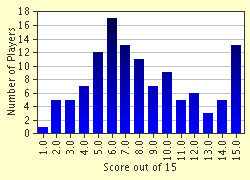Quiz Answer Key and Fun Facts
1. Even as a child, Stephen Gould was obsessed with dinosaurs. However, dinosaurs were not as 'cool' in the 40s as they are today. What nickname did Gould earn for his interests?
2. Stephen Gould became a professor at a very young age- 26. At what university did he teach?
3. At the age of 30 Stephen Gould and Niles Eldredge co-authored a paper on a new theory of evolutionary science quite different from strict Darwinism. What was this theory called?
4. Stephen Gould was most famous as an author of short essays on science. In which magazine were these essays originally published?
5. One of Stephen Gould's books was titled 'The Panda's Thumb.' What did the panda's thumb have to do with evolution?
6. One of Stephen Gould's works was called 'The Mismeasure of Man.' What was this book about?
7. Stephen Gould wrote many essays for the 'New York Review of Books.' However, many of them were not about books on science. What were they about?
8. Another of Stephen Gould's reviews for the 'New York Review of Books' was a scathing review of a book by Charles Murray. What was the subject of this book that so aroused Gould's ire?
9. Stephen Gould appeared as an expert witness in several court cases. What did the cases concern?
10. Stephen Gould appeared as himself on one episode of a famous television series. Which one?
11. Fill in the blank for the following quote from Stephen Gould - 'Teaching _____________ is like teaching English but making grammar optional.'
12. What were Stephen Gould's political views best characterized as?
13. Which of the following was a hobby of Stephen Gould?
14. In 1980, Stephen Gould was diagnosed with abdominal mesothelioma, a type of cancer. The cancer went into remission for some years, then returned. Gould worked very hard to finish his magnum opus, probably knowing that he had little time left. What was this book called?
15. Another of Stephen Gould's most famous essays is called, 'The Median Isn't the Message.' What is the subject of this essay?
Source: Author
crisw
This quiz was reviewed by FunTrivia editor
gtho4 before going online.
Any errors found in FunTrivia content are routinely corrected through our feedback system.

